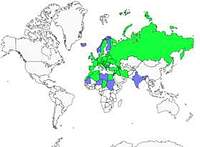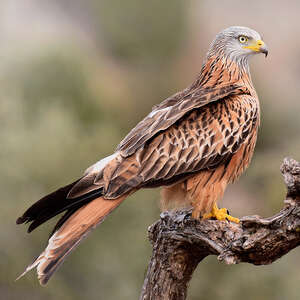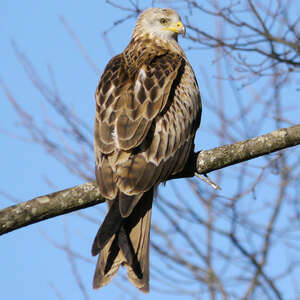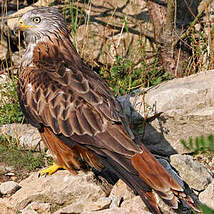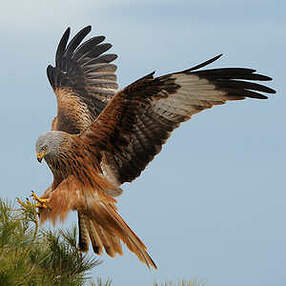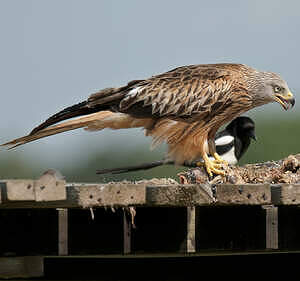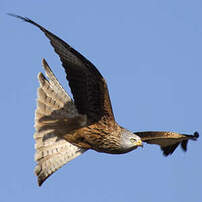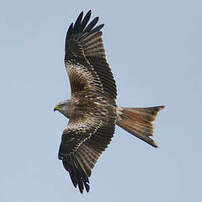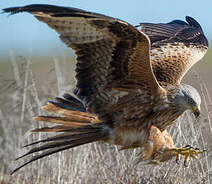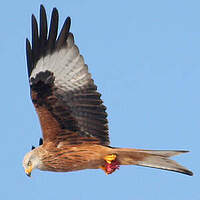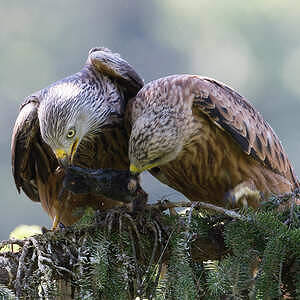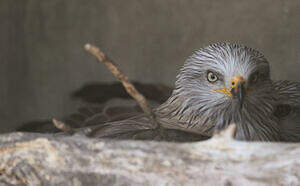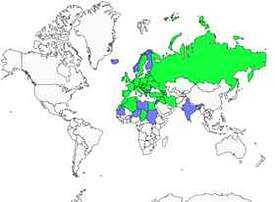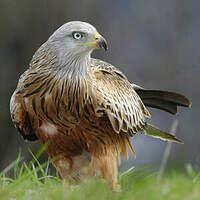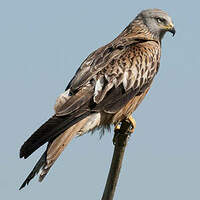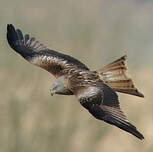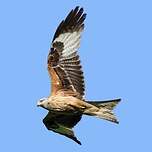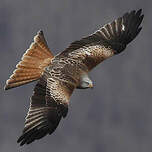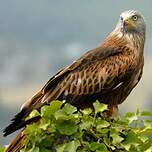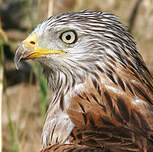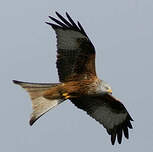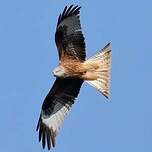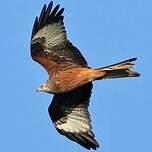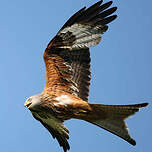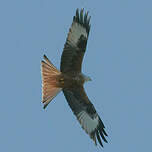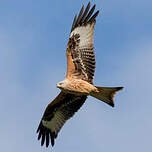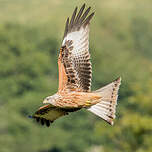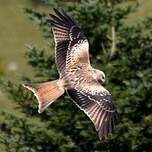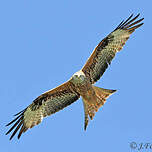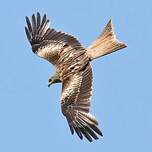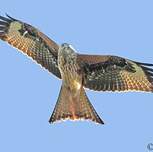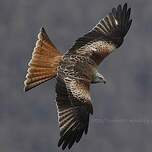Red Kite
Milvus milvus - Milan royal
Identification
The Eurasian continent houses two species of kites, the Red Kite and the Black Kite, close enough that their description relies on a comparison of the two species. The Red Kite is the largest, longest, and palest in plumage. When perched, the specific distinction may not be obvious, but in flight, the differences are more visible. The Red Kite is quite a large raptor, larger than the Common Buzzard for example. Its length is between 60 and 70 cm, its wingspan 145-170 cm, and its weight 800-1600 g. These figures suggest a real difference between male and female, as well as individual differences depending on physiological condition. The silhouette of the Red Kite is finer and longer, due to a longer tail that clearly protrudes beyond the wing tip, while the Black Kite's rectrices do not protrude. The adult Red Kite has a head that is very pale grey and finely streaked with dark, but be careful, in full sun the grey head of the Black Kite can appear quite light. The iris is a very pale yellow, sometimes almost white. The upper portions appear to be brown, with a medium brown mantle and lighter covers. These last ones are brown but largely bordered with reddish-brown, forming an elongated pale zone on the wing, more marked than on the Black Kite. The tip of the wing is brown-black. The tail is clearly reddish-brown above, slightly darker on the edges, while it is never reddish on the Black Kite. The lower parts are a fairly light cinnamon-brown and clearly streaked with brown. But be careful, an adult Black Kite in full light can appear distinctly russet, but darker. The tail is whitish-grey below, the outer rectrices darkened and sometimes lightly barred. The juvenile is much less russet above and below.The wings of Red Kite are paler, almost whitish. The head is less grey, with a dark top and a russet tail top marked with dark. The underside of the body is creamy-reddish, heavily streaked with brown and the underside of the tail is whitish and sharply barred with brown. The immature plumages are intermediate. Identification in flight is much easier. The red tail alone is determinative. The difference in length of the rectrices is obvious, giving a forked tail when resting, slightly concave when spread. In the black, the brown tail is shorter, triangular when spread. The wings of the royal, longer, are also much more contrasted than those of the black, above and below. The white hand plumes are very clear. They are sloping at the ends, which, combined with the long tail and slow flight, give it a characteristic silhouette.
Subspecific information 2 subspecies
- Milvus milvus milvus (Europe and nw Africa to the Middle East)
- Milvus milvus fasciicauda (Cape Verde Is.)
Foreign names
- Milan royal,
- Milano real,
- milhafre-real,
- Rotmilan,
- vörös kánya,
- Rode Wouw,
- Nibbio reale,
- röd glada,
- Glente,
- haja červená,
- luňák červený,
- Rød Glente,
- isohaarahaukka,
- milà reial,
- Svölugleða,
- kania ruda,
- sarkanā klīja,
- rjavi škarnik,
- Красный коршун,
- アカトビ,
- 赤鸢,
- röd glada,
- 紅鳶,
Voice song and call
The most common call of the Red Kite is a long, modulated whistle with a piuuuuuuuuuuuuu ui ui ui ui at the end. The call of the Black Kite is a simple, quavering piuuuuuuuu. The Red Kite is mostly vocal near the nest, much less or not at all elsewhere or outside of the breeding season.
Habitat
The Red Kite has two requirements to be present as a breeder. Firstly, it needs very open spaces for aerial hunting with capture on the ground.
Behaviour character trait
Red Kites behave in the air a little like vultures. Like them, they circle for a long time above their domain, using the same ascending currents. They easily glide rarely resorting to flapping flight when the weather allows it. They use their spread, highly mobile tails in a unique way in the world of raptors. They tilt it from side to side following the movements of the air to keep the balance of flight. This is particularly spectacular in the Red Kite. The tail plane can then make an angle of 45° or more with the wing plane. The Red Kite is an opportunistic to food search and there is a moment where we see kites, both royal and black, gathering together to benefit from the bounty, it is time for mowing.
The rapid cutting of the grass by modern mowers harshly exposes the soil of the meadows, making a large number of vertebrates and invertebrates accessible to predators, some injured or killed by the blade. This can include hares, young roe deer, birds ... The ballet of kites and other scavengers inevitably attracts attention. The royal kite, monogamous, lives in a solitary couple in the summer. But outside the breeding period, they often associate with their congeners and readily gather, no longer being confined to their territory. Migratory Red Kites gather at night in dormitories in large trees where local birds can join them. The same goes for wintering birds in the southwest wintering areas. With global warming, more and more Red Kites are settling, including in northern countries such as southern Sweden. The presence of landfill sites should also not be foreign to this settlement.Flight
The flight of the Red Kite is a flight with soft, slow beats. One gets the impression that it is flying with no effort.
Whenever possible, it practices the gliding flight for which it is very talented. When hunting, it hovers over the land at a height of 10 to 30 meters, head turned towards the ground which its very effective eyes scrutinize. It explores the land, somewhat like buzzards do but from higher up. It covers much more of the ground than they do and seems indefatigable in its search. At the moment of settling down, the couple performs a lengthy circle in the skies above the territory. There is an aerial parade that is quite acrobatic, showing off the flying capabilities of the species. This is composed of dives and ascents, pursuits, locked talons and so on, all punctuated with cries. The migratory flight is typical. The Red Kite migrates in small cohesive groups. The birds systematically search for thermal air currents in which they hover to gain as much altitude as possible. Then they glide down in a gliding flight, one behind the other, along the migratory path until the next pump.Dietfeeding habits
Kites are primarily scavengers. Red Kite is no exception. The corpses of vertebrates, particularly those crushed on roads or those killed by the harvester, irresistibly attract it.
He systematically visits waste disposal sites, regularly inspects manure piles, and looks for opportunities. But he is also a hunter who captures living prey, invertebrates and vertebrates, detected in flight and on which he lands. The spectrum is very wide, ranging from earthworms to small mammals, amphibians-reptiles, birds and various insects. He is less inclined to capture flying insects than his congeners. The diet reflects the diversity of local resources. GPS tracking has shown that the hunting territory sizes of breeding males range from 5 to 500 km² depending on the abundance of the resource. The range is huge and one can imagine that the richness of a territory can have a direct impact on reproductive success. There can also be big inter-annual differences on the same territory.Reproduction nesting
The couple reinvested the territory at the end of March or the beginning of April. The male and female birds would parade in the air flying together above the nesting site, most often a light forest lined with pastures. The partners would grab each other with their talons and spiral down, wings open until the top of the trees. They would also circle around the site for a long time, emitting their cries, making short dives in pursuit of each other. Quickly, they would get to work either building or more commonly rehabilitating an old nest. The nest is located high in a tree, more than 10 meters high, on a fork of the trunk or a large lateral branch.
The tree that supports it is usually a deciduous tree in the plains, most often an oak tree, and a conifer or a beech tree above 800 meters. The nest is quite voluminous. It is a platform made of dry branches, which are on average larger than those of buzzard or Red Kite nests. The birds included paper or plastic in the nest, but not as systematically as their close relative. The inside is lined with dry grass or sheep wool. The female lays 2 or 3 eggs (1 to 4) every three days. The eggs are bright white with spots of purple or red. Incubation starts as soon as the first egg is laid, and is done mostly by the female. Occasionally, the male will replace her for a short period of time. Incubation lasts 31 to 32 days for each egg, which is around 38 days in total for a cluster of 3 eggs. The chicks keep their chamois-colored newborn down for 14 days and then exchange it for a reddish down. The male feeds the family at the beginning but will have a major nourishing role until the end. The young are ready to fly at around the age of two months. At the end of their stay in the nest, the young are able to feed themselves on the prey brought to them by the adults.Adults can go hunting for miles away from the Red Kite's territory.Geographic range
The distribution of the Red Kite is essentially European. The range is continuous from Spain to Belarus, passing through France, Germany, Lithuania and Poland. But the center of the range is clearly western, with Spain, France and Germany hosting the majority of the population. But the situation is changing. After a sharp decline in the 20th century, the species is in poor condition in the south of its range, for example in Spain, while it is in full expansion in the north where it is better protected. In Scandinavia, the bird is strongly increasing in the south of Sweden and has settled down. The British Isles have recently become a stronghold of the species as a result of a well-conducted conservation program. To the east of this range, there are more or less isolated populations in the majority of European countries and up to the west of Russia. The western Mediterranean islands are inhabited. The range slightly extends into the north of Morocco. The subspecies fasciicauda of the Cape Verde Archipelago is considered extinct. The Red Kite is a partial migrant. Birds from the northeast of the range from northeast France are migratory and mainly travel in the autumn towards Spain and southern France. Some pass through the Strait of Gibraltar. Winter visitors mix with local birds and are distributed based on resources.
Threats - protection
IUCN conservation status
concern
in the Wild
threatened
evaluated
The decline observed in the 20th century to varying degrees depending on the region is fairly easily explained. The main cause lies in the indirect poisoning to which it is victim. A well-known example: at the end of the last century in France, in the grassland areas of the center and northeast, a pest was fought with a very toxic substance, Bromadiolone. Red Kites were poisoned by consuming the dead rodents. In general, the illegal use of poisons against various animal targets, quite widespread in many places, is a major cause of mortality of Red Kite. Locally, it has been, and can still be, directly destroyed. The modification of agricultural landscapes and their crop rotation as well as the intensification of forestry exploitation consequent to the deterioration of trees can have a negative impact. Finally, in addition to electrocution on pylons and collisions with cables, Red Kites are facing a new mortality factor, wind turbines, before which they are quite vulnerable. Mortality surveys are organized. Fortunately, there is more to it than just bad news. After the decline of the last century, conservation measures have been taken in several countries, the positive effect of which has been felt quickly. Thus in Sweden, from 30-50 couples in the 70s, the population was 1,800 couples in 2007 and the growth continued at a rate of 13% per year. Great Britain has also become a bulwark with 2,200 couples in 2010 and an estimated capacity of 10,000 couples. At the same time, the species is not doing well in the south, for example in Spain. There is a demographic shift in favor of the north of the area.
Sources of information
- IOC World Bird List (v15.1), Gill, F and D Donsker (Eds). 2025-12-07.
- Les rapaces diurnes et nocturnes d'Europe, M. Cuisin, P. Geroudet
- Birds of the World, The Cornell Lab of Ornithology
- xeno-canto, Sharing bird sounds from around the world,
Other sources of interest
 Specification sheet created on
10/07/2023 by Jean François
Specification sheet created on
10/07/2023 by Jean FrançoisTranslation by AI Oiseaux.net
© 1996-2025 Oiseaux.net
- Accipitriformes
- Aegotheliformes
- Anseriformes
- Apodiformes
- Apterygiformes
- Bucerotiformes
- Caprimulgiformes
- Cariamiformes
- Casuariiformes
- Charadriiformes
- Ciconiiformes
- Coliiformes
- Columbiformes
- Coraciiformes
- Cuculiformes
- Eurypygiformes
- Falconiformes
- Galliformes
- Gaviiformes
- Gruiformes
- Leptosomiformes
- Mesitornithiformes
- Musophagiformes
- Nyctibiiformes
- Opisthocomiformes
- Otidiformes
- Passeriformes
- Pelecaniformes
- Phaethontiformes
- Phoenicopteriformes
- Piciformes
- Podargiformes
- Podicipediformes
- Procellariiformes
- Psittaciformes
- Pterocliformes
- Rheiformes
- Sphenisciformes
- Steatornithiformes
- Strigiformes
- Struthioniformes
- Suliformes
- Tinamiformes
- Trogoniformes


